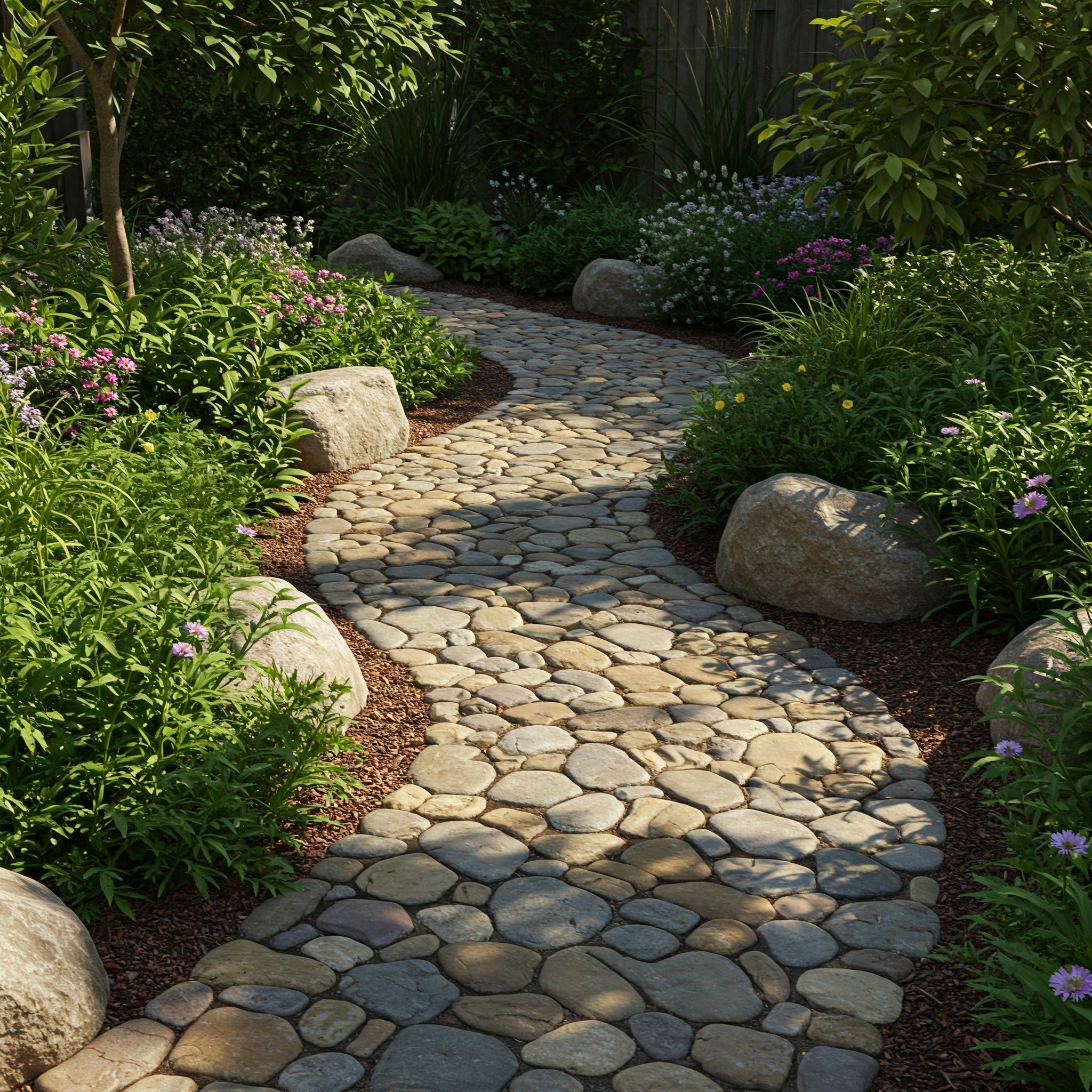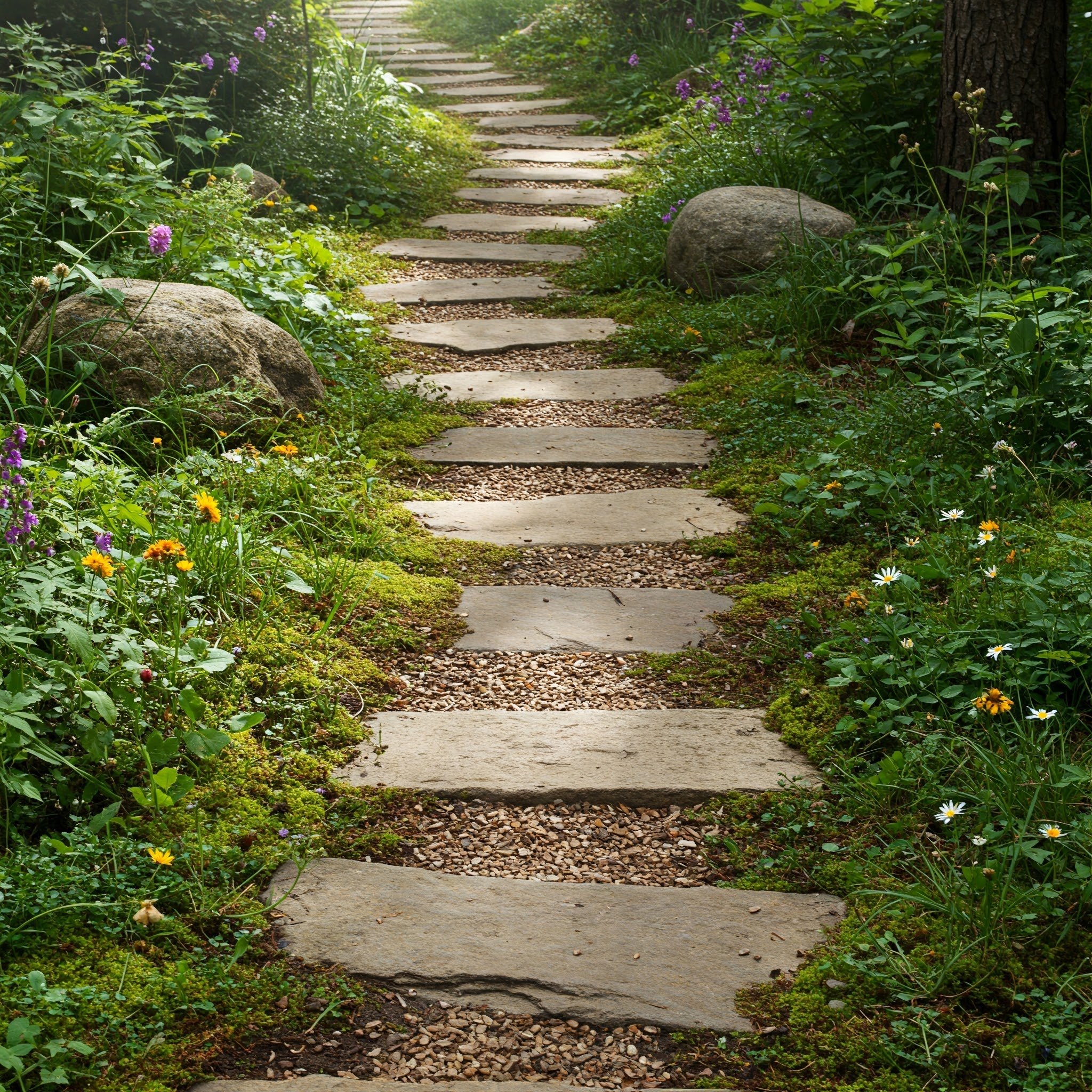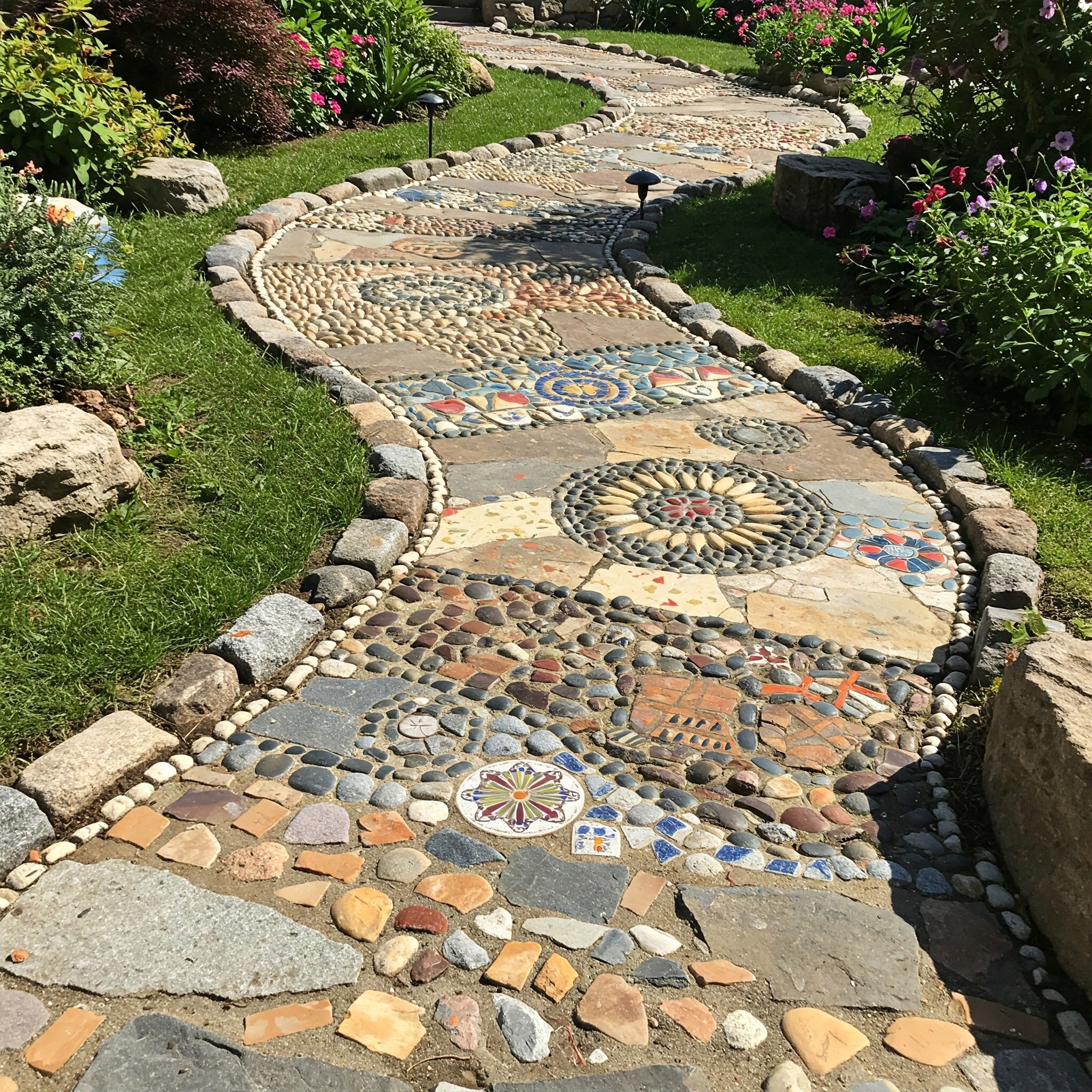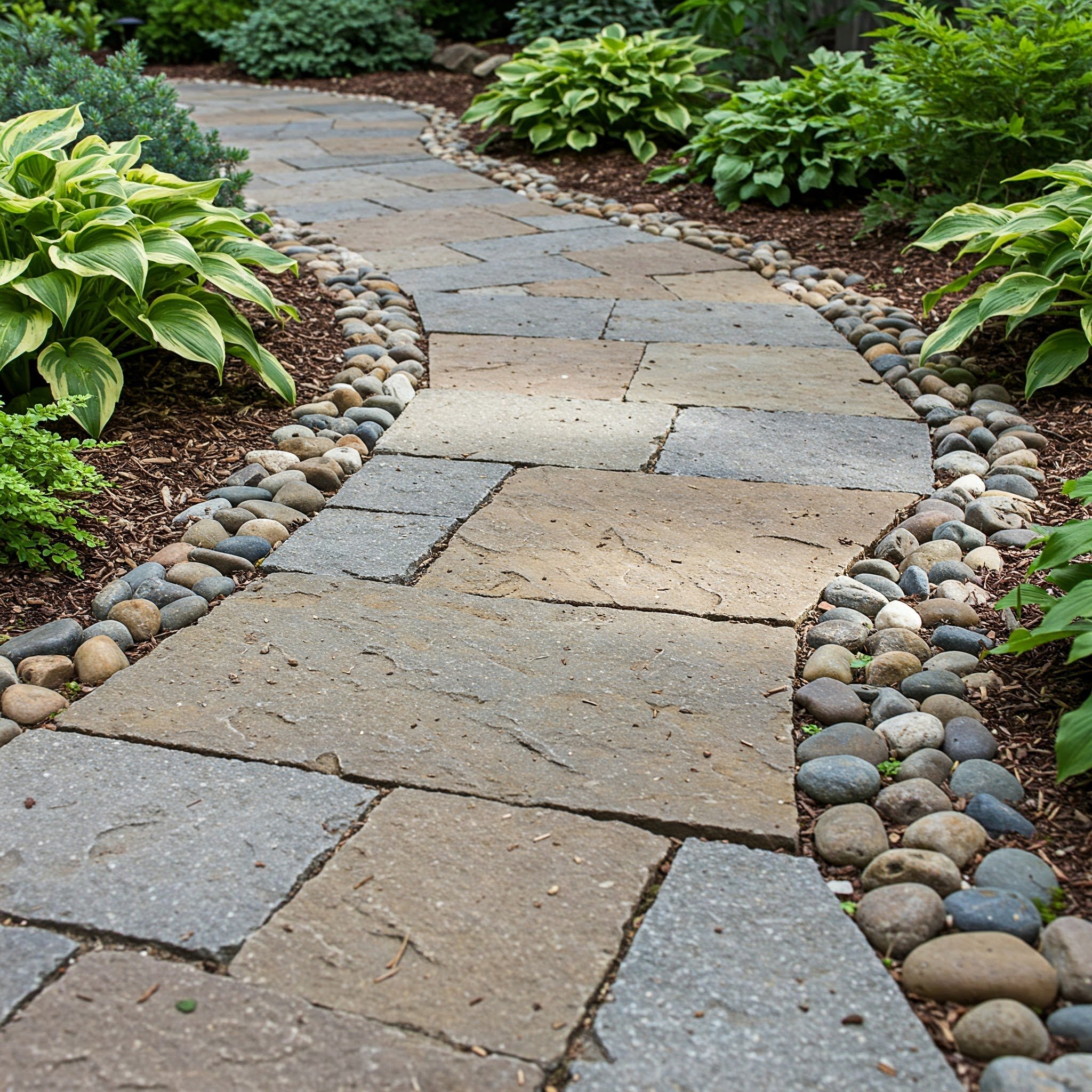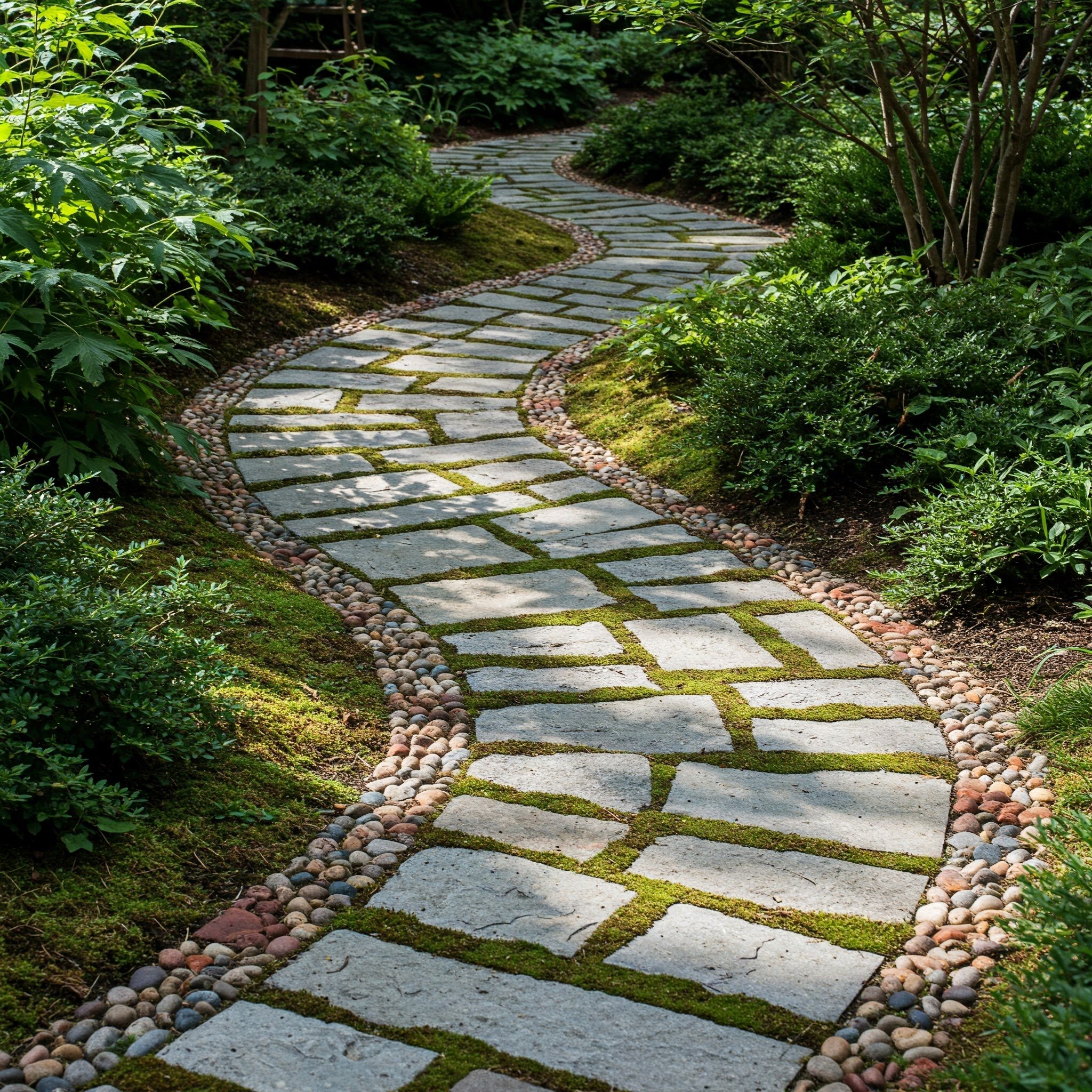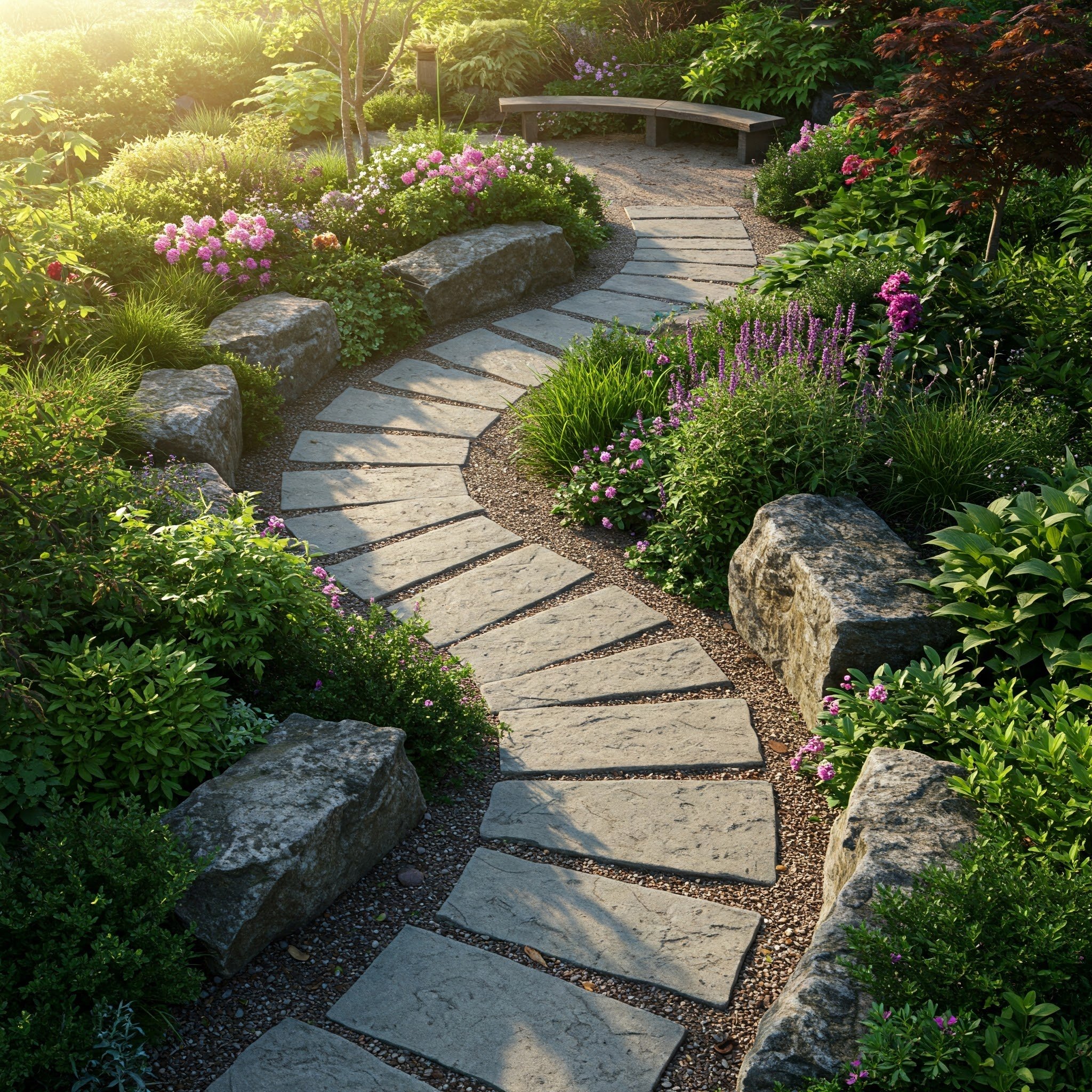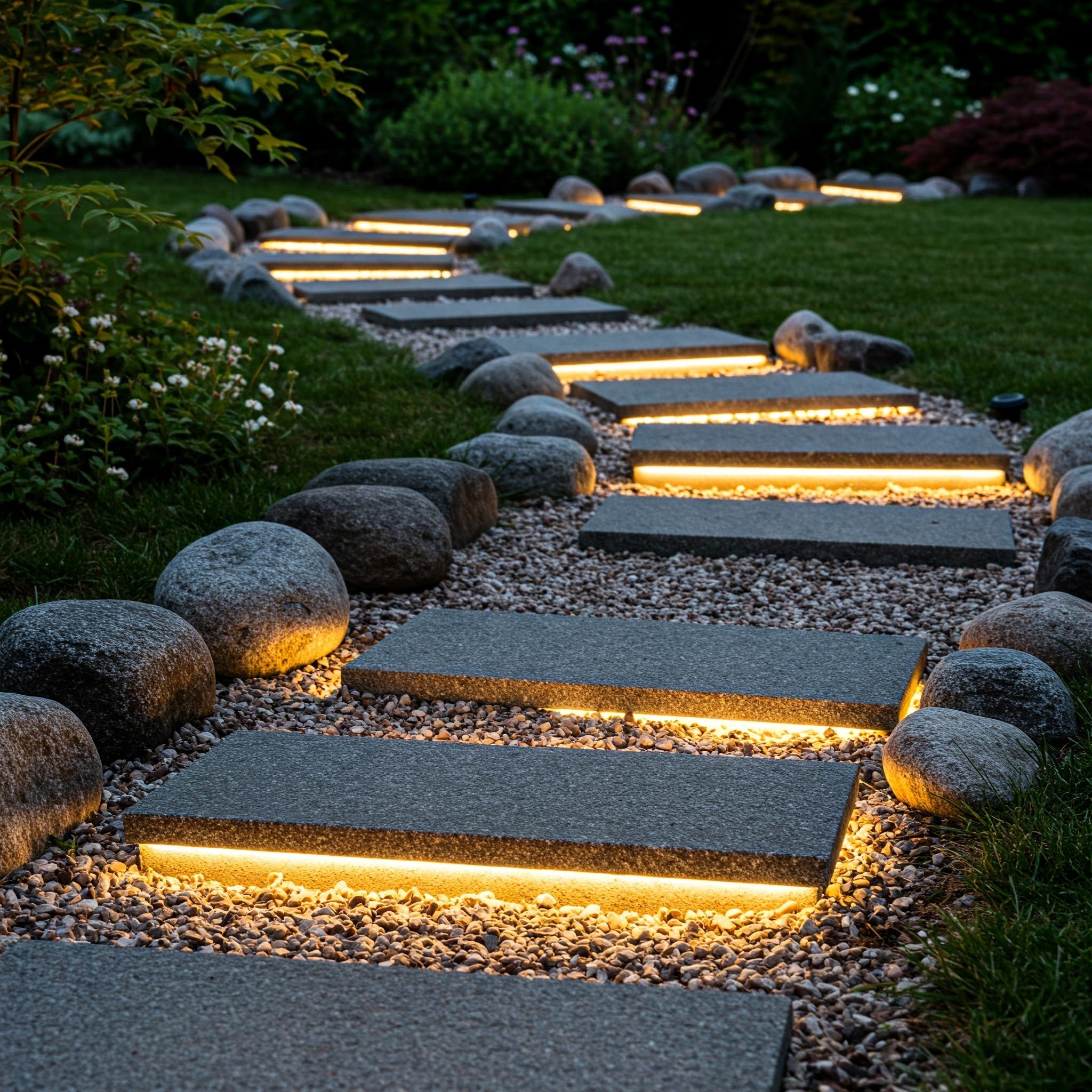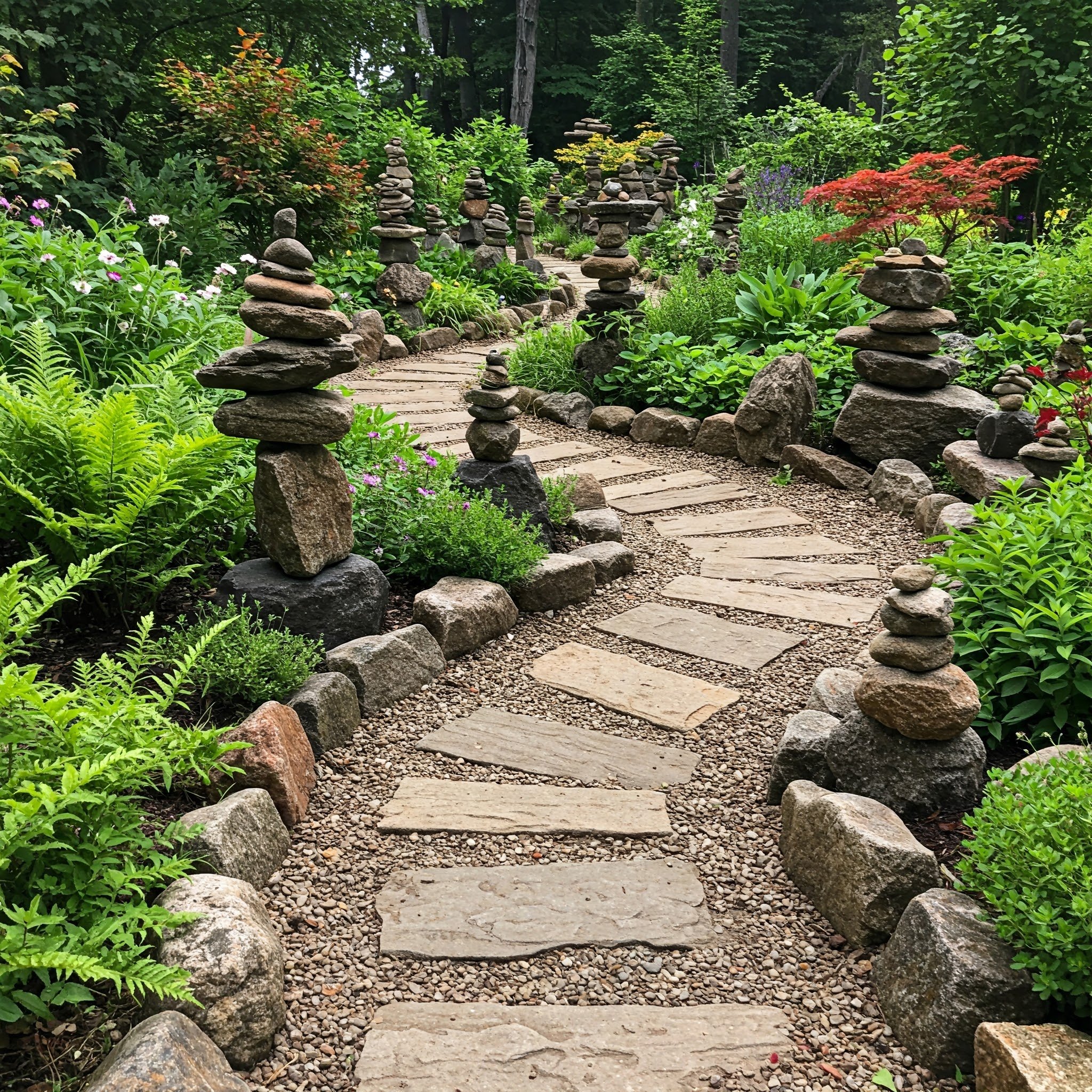15 Rock Walkway Ideas for a Stunning Garden Path
Elevate your garden design with these 15 creative rock walkway ideas. Discover pathways that blend function and flair, featuring everything from natural stepping stones to sleek gravel mosaics.
Have you ever strolled through a garden that felt like stepping into a painting? The secret often lies underfoot—a captivating rock walkway can transform an ordinary patch of green into something truly magical. Whether you’re aiming for a rustic cottage vibe or a modern Zen retreat, rocks offer a natural element that’s both versatile and durable. Perhaps you picture a meandering stone path lined with fragrant blossoms, or maybe you see a minimalist walkway that complements sleek outdoor seating. Rock walkways aren’t just about aesthetics, though; they also help protect delicate plants and define the flow of foot traffic. Ready to embark on a design journey that brings your garden fantasies to life? Let’s explore 15 rock walkway ideas that promise to inspire and delight.
1. Natural Stepping Stones for Organic Charm
Natural stepping stones offer a whimsical way to wander through your garden, each rock acting like a gentle invitation to move forward. Often made from slate, sandstone, or even large flat river stones, these pieces have a raw, earthy charm that pairs beautifully with foliage. Imagine placing them in a soft bed of moss or groundcover, so each step feels like a playful hop across a hidden forest path. Some people leave generous gaps between stones to encourage clusters of plants to creep in and around, adding a spontaneous, woodland feel. Consider how the shape of each stone can influence the vibe—rounded edges provide a softer look, while angular pieces might suit a more modern aesthetic. In essence, natural stepping stones are a subtle yet eye-catching way to guide guests, turning a simple walk into a mini nature adventure.
2. Gravel Pathways with Clean Lines
If you lean toward a contemporary style or crave a tidy, minimalist look, gravel pathways could be just the ticket. Gravel is affordable, drains well, and offers a satisfying crunch underfoot that feels almost musical as you wander through your garden. You can outline the path with metal edging or bricks to keep the stones contained and maintain a crisp silhouette. One of the coolest perks about gravel? It complements nearly any garden theme—add a few modern sculptures for a sleek urban feel, or border your path with flowering perennials for a cozy cottage vibe. Also, gravel’s neutral color palette makes your plants pop, letting foliage or blooms steal the show. It’s wise to install a weed-blocking fabric underneath, ensuring your sparkling new walkway remains low-maintenance and fuss-free over time.
3. Flagstone Elegance in a Cottage Garden
Flagstone walkways evoke an instant sense of timelessness, like you’ve stepped back into an old English countryside. The stones themselves typically come in irregular shapes, adding a gentle, organic quality to your yard. Each flagstone piece has unique ridges, hues, and textures, which can play beautifully with surrounding greenery. In a cottage-style garden, consider planting creeping thyme or other aromatic groundcovers in the gaps to create a patchwork effect that’s both practical and romantic. The result is a tapestry of stone and greenery that begs you to meander along, cup of tea in hand. Plus, flagstone stands up well to foot traffic while still maintaining its natural beauty, making it a great long-term choice. If you crave something extra special, choose stones that reflect the local geology, tying your walkway intimately to its environment.
4. Mosaic Rock Patterns for an Artistic Touch
Ever think about turning your walkway into a canvas? Mosaic rock patterns let you do exactly that, merging function with fine art. By carefully arranging stones of different colors and shapes—think pebbles, broken tiles, or flattened river rocks—you can create intricate designs like spirals, flowers, or geometric shapes. It’s a labor of love, but the payoff can be astonishing, especially when sunlight hits the stones and highlights each detail. The mosaic approach works beautifully in smaller garden nooks, where guests can pause to admire the craftsmanship. It’s also a way to infuse personal flair; for example, you might incorporate meaningful symbols or favorite hues into the pattern. While mosaic rock pathways may require a bit more planning and effort, they promise a one-of-a-kind statement piece that transforms your garden into an art lover’s haven.
5. River Rock Trails for a Subtle Tactile Experience
There’s something undeniably soothing about the smoothness of river rocks, worn down over eons by flowing water. When used in a garden path, they add both visual and tactile intrigue—imagine walking barefoot on a warm afternoon, feeling each stone’s gentle contours. These rocks typically come in soft earth tones like grays, browns, and muted greens, blending seamlessly with nature’s palette. You might choose to create a narrow trail of river stones or pepper them between larger stepping stones for contrast. This style works especially well near water features, like a small pond or trickling fountain, to echo the theme of flowing water. And while river rock pathways are generally low-maintenance, be sure to use edging materials to keep the stones from scattering, preserving that tranquil, cohesive look you’re after.
6. Rock and Mulch Combinations for Visual Interest
Sometimes, the perfect garden pathway involves pairing two or more natural materials. Rock and mulch combinations can break up the monotony of a single-texture path, creating a pattern that feels both balanced and inviting. You might place larger flat stones as stepping points, filling the surrounding space with mulch for a softer, earthy backdrop. This approach can be especially handy if you’ve got trees and want to protect their roots, since mulch improves soil health and water retention. Meanwhile, the stones themselves can handle foot traffic and offer secure footing. The contrast between the deeper color of bark mulch and the lighter tones of rock can be a feast for the eyes, guiding visitors through your garden in style. Even better, mulch is easy to refresh periodically, ensuring your path remains looking crisp and well-kept.
7. Incorporating Pebble Accents Around Plant Beds
Pebbles aren’t just for fish tanks—they can also add a delicate, refined touch to your garden walkway. Picture small, polished stones in white, black, or even colorful blends framing the edges of each step. They might line the perimeter of a larger path or create a playful border around clusters of flowers and shrubs. The smaller size of pebbles means they can fill in tight corners and spaces where larger rocks wouldn’t fit as seamlessly. You could also get creative by adding a pebble “stream,” making it look like a dried river winding through your garden. This small-scale approach can have a big impact, drawing the eye toward specific plants or architectural features. Whether you’re aiming for Zen-like simplicity or a more dynamic scene, pebbles deliver a polished vibe that’s easier to maintain than you might think.
8. Mixing Large and Small Stones for Dimension
Variety is the spice of life, and your garden path is no exception. Combining large and small stones can create dimension, depth, and a sense of organized chaos that feels wonderfully organic. For instance, you might use big slabs of natural rock as the main stepping surfaces, then fill gaps with crushed gravel or pebble mosaics. The contrast in size ensures each element stands out, yet the entire path reads as one cohesive design. This approach can also help you work with tricky land contours—larger stones are ideal for stabilizing slopes or creating mini retaining walls. Plus, the interplay of textures and colors keeps the eye engaged, encouraging guests to linger a little longer on every step. If your style leans toward eclectic or bohemian, this method can help you channel that carefree, earthy vibe without sacrificing function.
9. The Serenity of Zen-Inspired Walkways
Sometimes, less really is more. A Zen-inspired rock walkway taps into the art of simplicity, focusing on clean lines, balanced shapes, and a sense of calm. Picture smooth white gravel neatly raked into patterns, or carefully placed stepping stones leading to a small meditation corner. You could flank the path with sculptural plants like bamboo or Japanese maples, further emphasizing the Zen aesthetic. Even the act of maintaining such a path can be meditative—raking the gravel, adjusting rocks, and trimming plants become rituals that help you connect with nature. Whether your garden is large or small, a Zen-inspired approach can create an oasis of peace, where every crunch of gravel underfoot feels like a gentle invitation to slow down and breathe.
10. Rock Paths with Decorative Borders
A rock path might be functional at its core, but who says you can’t dress it up? Decorative borders can elevate a straightforward stone pathway into something that feels intentionally designed. You could use bricks, wooden edging, or metal strips to outline the path, preventing gravel or small stones from wandering into the lawn. Another idea is to line the walkway with larger rocks, creating a natural “fence” that frames each step. This visual boundary can be particularly striking if you choose stones that contrast in color with your main path material. Think dark, smooth river rocks against a light gravel path, or vice versa. Decorative borders also offer an opportunity to incorporate pops of color—plant a row of vibrant flowers, ornamental grasses, or even small solar lights for added ambiance when the sun goes down.
11. Elevated Stone Steps for Tiered Landscapes
If your garden is on a slope or has multiple levels, consider turning that challenge into an advantage with elevated stone steps. Large, sturdy slabs of rock can be stacked to form a staircase that both smooths out the incline and creates visual drama. The look can range from rustic—using big, textured boulders—to refined, with precisely cut rectangular stones that lend a modern feel. Each tier can become a mini landing, perfect for potted plants or a small seating area. Imagine pausing on each level to take in the view, as though your garden is unveiling itself step by step. Elevated stone steps also help control erosion and direct foot traffic. It’s the sort of design that says, “Yes, this yard might be hilly, but we’re turning it into a multi-level delight.”
12. Curved Walkways that Embrace the Garden Flow
Straight lines can be stunning, but curves often mimic nature’s own shapes. A curved rock walkway has a gentle fluidity that feels welcoming, as though it’s guiding you on a quiet stroll. This design can help you showcase different pockets of your garden—each bend reveals a new cluster of flowers, a cozy seating area, or even a charming birdbath. Curves can also break up a boxy yard or soften the edges of a patio. When laying out the path, use a flexible hose or rope to visualize the curve before placing stones, ensuring you get the exact flow you want. Because curved paths can naturally slow down your pace, guests have the chance to linger, admire blossoms, and truly soak in the ambiance. It’s almost like dancing through the garden, one graceful step at a time.
13. Using Flat Stones for Seamless Transitions
Sometimes you want a walkway that doesn’t shout “I’m a pathway!” but rather whispers it, blending effortlessly with the surrounding lawn or patio. Flat stones can do just that, offering enough surface area for stable walking while remaining unobtrusive. In fact, if you set the stones level with the earth, your mower can glide right over them. This approach is especially handy for transitional spaces between the yard and a deck, or around a pool where you need a non-slip surface. The stones can be spaced out or placed close together, depending on how much of a statement you want them to make. Consider matching the stone color to your house or fence for a cohesive look, or choose something contrasting to highlight each step. Either way, it’s a technique that merges practicality with understated elegance.
14. Integrating Lighting Along Rock Paths
Garden pathways don’t have to fade away after sunset. By adding strategic lighting, you can transform your rock walkway into a magical nighttime experience. Think low-voltage LED lights nestled between stones, solar-powered lanterns hanging from small hooks, or even recessed lights built into bordering walls. The interplay of light and shadow can highlight the textures of each rock, turning your garden into a moonlit gallery. Lighting also adds an element of safety, guiding guests along the path without fumbling in the dark. You could choose warm, amber tones for an intimate vibe, or cool, white lights for a more contemporary look. Either way, illuminated rock walkways can turn a simple evening stroll into an enchanting escapade, giving you a new perspective on even the most familiar corners of your yard.
15. Creating Focal Points with Unique Rock Arrangements
Finally, let’s talk about adding a touch of drama. Unique rock arrangements—such as large boulders placed strategically within or alongside your walkway—can serve as striking focal points. Maybe you’ve found a particularly eye-catching stone with swirling patterns or a distinctive shape. Placing it near a turn in the path can pique curiosity, prompting visitors to wander just a bit farther. You could also stack stones in an artistic cairn for a Zen vibe, or situate a cluster of smooth, polished rocks that glisten after a rain. These focal points add a sense of personality, like hidden treasures waiting to be discovered. They also encourage you to pause and appreciate the natural artistry of rock formations. When done thoughtfully, these arrangements make your garden path not just a route, but a journey filled with surprises.
Conclusion
A gorgeous rock walkway is more than just a path—it’s an invitation. Every step along the stones can transport you deeper into your own personal oasis, turning a routine stroll into a mini adventure. From Zen-inspired designs that champion simplicity to bolder mosaics that celebrate creativity, there’s a rock walkway style out there for every garden dream. Natural stepping stones bring a storybook feel, gravel offers modern practicality, and carefully placed boulders can act as conversation starters. Ultimately, the beauty of these pathways lies in how they reflect your vision and your willingness to get your hands a little dirty. So, gather your rocks, unleash your imagination, and watch your garden flourish underfoot, one stone at a time.
Frequently Asked Questions
1. Do I need professional help to install a rock walkway?
Not necessarily. Simple paths, like gravel or stepping stones, can often be done as DIY projects. However, if you’re dealing with uneven terrain or complex designs, consulting a landscaper can save time and ensure safety.
2. What’s the easiest rock material to maintain?
Gravel is generally low-maintenance; it drains well and doesn’t require heavy cleaning. Just remember to install edging or a border to keep it from scattering into the lawn.
3. How do I stop weeds from growing between my rocks?
Use landscape fabric or a layer of newspaper beneath the rocks, and consider adding a layer of sand or gravel. Occasional hand-weeding might still be needed, but this barrier greatly reduces unwanted growth.
4. Can I mix different rock types in one pathway?
Absolutely! Mixing stones can add depth and interest. Just be mindful of color and size contrasts, aiming for a harmonious balance that suits your overall garden design.
5. Are rock walkways safe in wet or icy conditions?
They can be, if you choose stones with some texture for grip and ensure proper drainage. Adding anti-slip sealants or salts in winter can also help improve traction.
